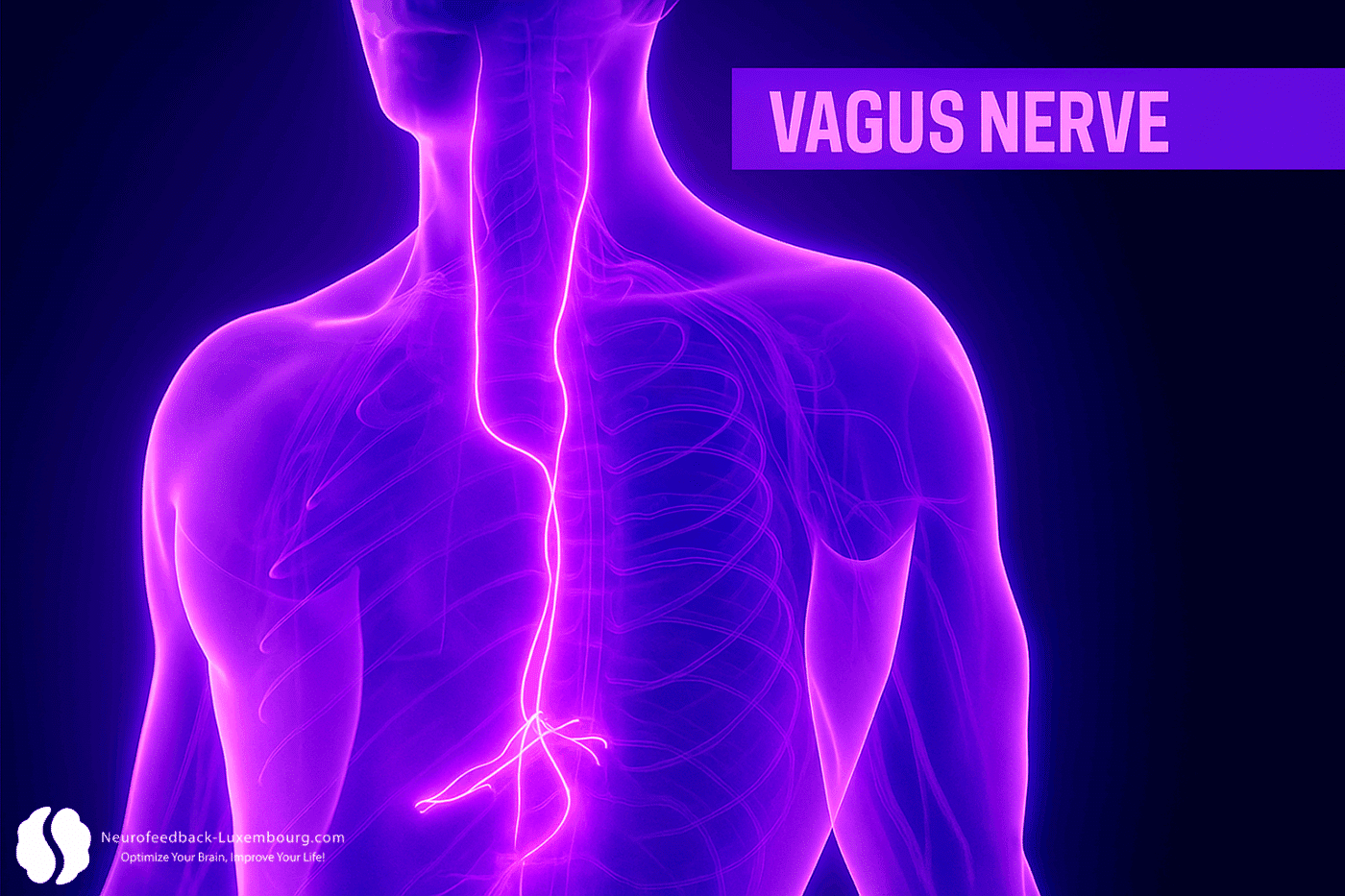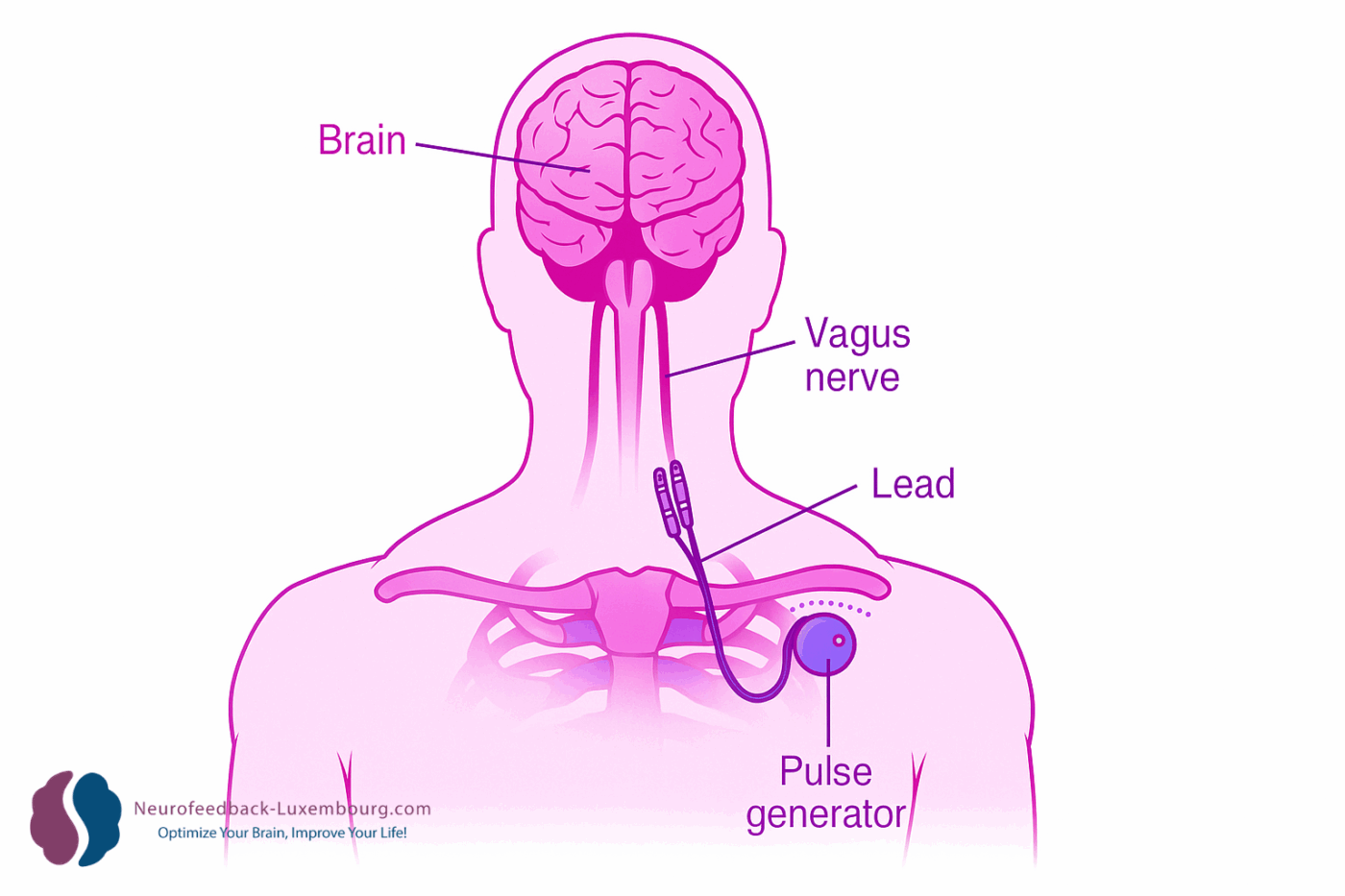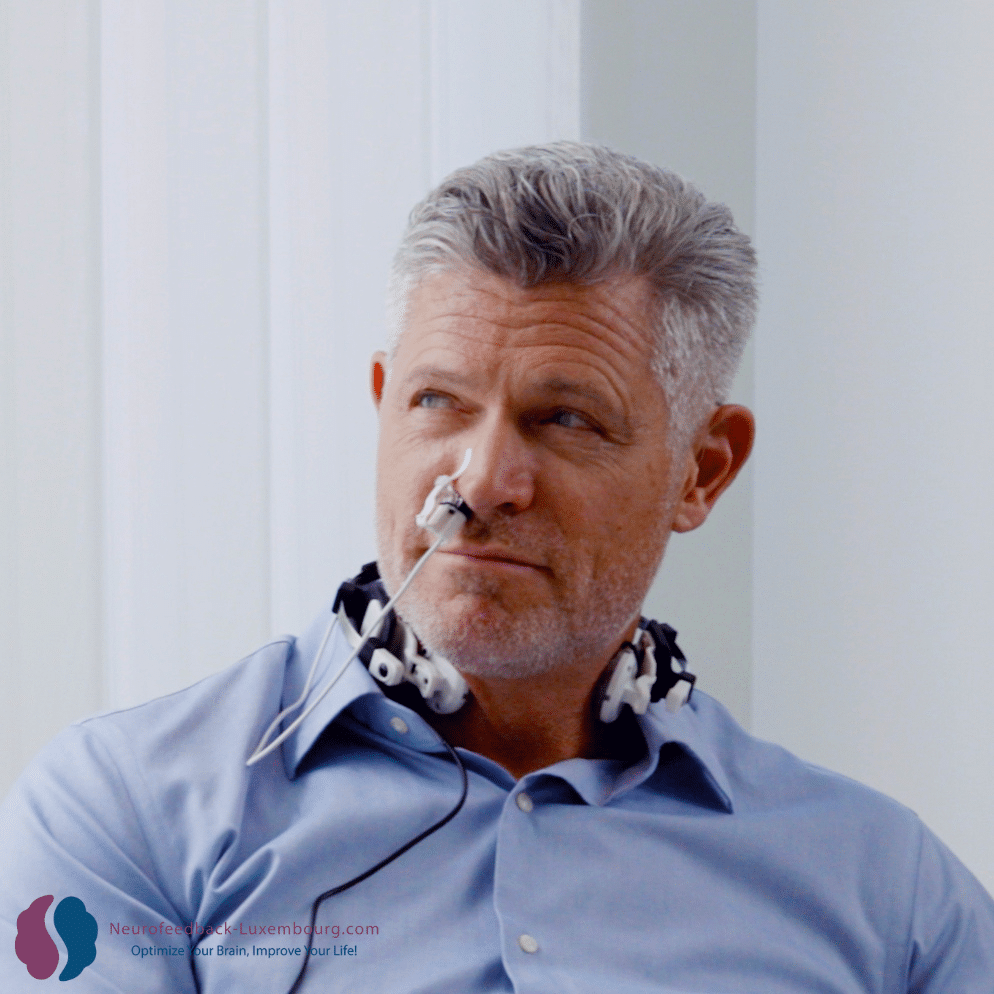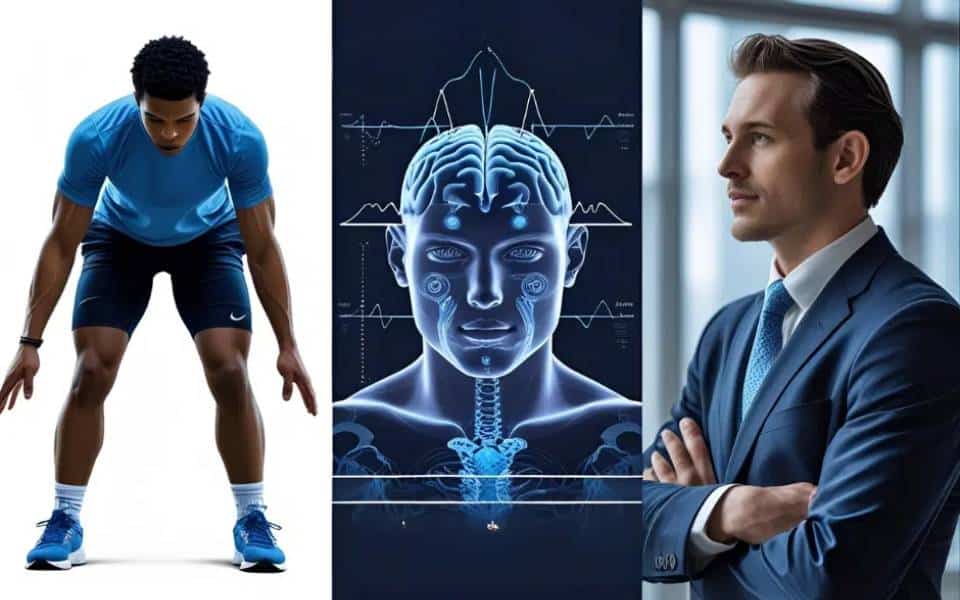Optimizing the Autonomic Nervous System for Enhanced Mental Performance and Comprehensive Well-being
The Foundation of Whole-Body Wellness: Understanding the Vagus Nerve

While neurofeedback has revolutionized our ability to train brainwave patterns directly, emerging research reveals that optimal cognitive performance and emotional regulation extend far beyond the brain itself. The vagus nerve, often called the “wandering nerve,” represents the longest cranial nerve in the human body and serves as the primary communication highway between the brain and vital organs throughout the body. The vagus nerves originate in the medulla oblongata and travel through the neck alongside the jugular vein and carotid artery. They extend into the chest and abdominal cavity, transmitting sensory and motor signals to and from various organs.
This remarkable neural pathway forms the cornerstone of our parasympathetic nervous system, orchestrating functions as diverse as heart rate variability (HRV), digestive processes, immune response, and inflammatory regulation. The parasympathetic nervous system controls heart rate, digestion, and other involuntary functions via the vagus nerve, in contrast to the sympathetic nervous system, which prepares the body for ‘fight or flight’ responses. At Neurofeedback Luxembourg, we recognize that true neurological optimization requires addressing both central nervous system training through neurofeedback and peripheral nervous system support through vagus nerve stimulation.
The Science Behind Vagal Tone and Mental Performance
Recent neuroscience research demonstrates that vagal tone – the strength and efficiency of vagus nerve function – directly correlates with:
Cognitive Performance Indicators:
- Enhanced attention and focus capacity (1)
- Improved working memory function (2)
- Greater emotional regulation stability (3)
- Accelerated learning and neuroplasticity (4)
- Optimized stress response and recovery (5)
Optimal vagal tone also supports the growth and maintenance of brain cells (6), which are essential for memory, learning, and overall cognitive function.
Physiological Markers:
- Improved heart rate variability (HRV) (7)
- Enhanced immune system function (8)
- Reduced systemic inflammation (9)
- Better sleep quality and circadian rhythm regulation (10)
- Improved digestive efficiency and gut-brain axis communication (11)
The vagus nerve’s influence on these systems creates what researchers term “physiological readiness” – an optimal internal environment that enhances the brain’s capacity for learning and adaptation. This concept proves particularly relevant for neurofeedback training, where the nervous system’s baseline state significantly impacts training effectiveness and retention.
Introducing Photobiomodulation-Based Vagus Nerve Stimulation
Traditional vagus nerve stimulation (VNS) has historically required invasive surgical implants or uncomfortable electrical stimulation devices, typically involving a vagus nerve stimulator. However, breakthrough photobiomodulation (PBM) technology now enables non-invasive, comfortable vagal stimulation through precisely targeted near-infrared light therapy.

Traditional vagus nerve stimulation (VNS) devices, by contrast, use a surgically implanted pulse generator. This battery-powered, programmable unit is typically placed under the skin in the chest and connected to the vagus nerve in the neck via a lead wire. The pulse generator sends electrical impulses or electrical signals at a programmed pulse frequency (measured in Hertz) through the lead wire to stimulate the vagus nerve. Adjusting the pulse frequency and the characteristics of the electrical impulses is crucial for optimizing therapeutic outcomes and minimizing side effects in conditions such as epilepsy and depression.
Unlike these devices, the Vielight Vagus does not send electrical impulses. Instead, it uses light to stimulate the vagus nerve, offering a non-invasive alternative to traditional electrical stimulation.
The Vielight Vagus represents the latest advancement in this field, utilizing 810nm near-infrared light to stimulate the vagus nerve through the neck’s carotid area. This innovative approach offers several distinct advantages:
Technical Specifications and Mechanisms
- Wavelength: 810nm near-infrared light, optimal for tissue penetration, 10Hz
- Target Area: Carotid sheath region where the vagus nerve is most accessible
- Session Duration: Auto-timed 20-minute sessions
- Mechanism: Photobiomodulation stimulates mitochondrial cytochrome c oxidase, enhancing cellular energy production within vagal nerve tissues
Clinical Benefits and Applications
Immediate Effects:
- Activation of the parasympathetic “rest and digest” response
- Measurable improvements in heart rate variability within sessions
- Enhanced sense of calm and mental clarity
- Reduced cortisol and stress hormone levels
Long-term Adaptations:
- Strengthened vagal tone and autonomic resilience
- Improved stress tolerance and recovery capacity
- Enhanced emotional regulation and mood stability
- Optimized inflammatory response and immune function
Traditional vagus nerve stimulation (VNS) is FDA-approved to treat epilepsy and has also been studied for major depression, bipolar disorder, rapid cycling bipolar disorder, cluster headache, cluster headaches, and even Alzheimer’s disease. Research continues to explore its potential benefits for a range of neurological and psychiatric conditions.
It is important to note that traditional VNS procedures can sometimes cause side effects such as neck pain or surgical complications, but these are generally mild and manageable.
Synergistic Integration with Neurofeedback Training
The combination of vagus nerve stimulation with neurofeedback training creates a powerful synergistic effect that addresses both central and peripheral nervous system optimization. This approach leverages both peripheral and central brain stimulation techniques for enhanced outcomes. This integrated approach offers several clinical advantages:
Pre-Training Optimization
Vagus nerve stimulation before neurofeedback therapy creates an optimal physiological state for learning by:
- Reducing baseline anxiety and stress responses
- Enhancing focus and attention capacity
- Improving parasympathetic nervous system activation
- Optimizing cortical arousal levels for effective training
Enhanced Training Effectiveness
The improved autonomic balance achieved through vagal stimulation directly supports neurofeedback training by:
- Increasing neuroplasticity and learning capacity
- Improving training session consistency and engagement
- Enhancing the transfer of learned patterns to daily life
- Reducing training session variability due to stress or arousal fluctuations
Accelerated Results and Durability
Clients utilizing combined VNS and neurofeedback protocols often experience:
- Faster achievement of training objectives
- More stable and lasting improvements
- Enhanced generalization of benefits beyond training sessions
- Improved overall treatment satisfaction and engagement
Clinical Applications and Target Populations
Performance Enhancement
Executive Professionals:
- Enhanced decision-making under pressure
- Improved stress resilience and recovery
- Optimized cognitive performance during demanding periods
- Better work-life balance through improved autonomic regulation
Athletes and Performers:
- Enhanced focus and concentration during competition
- Improved recovery between training sessions
- Better stress management and performance anxiety reduction
- Optimized autonomic nervous system balance for peak performance
Wellness and Health Optimization
Stress and Anxiety Management:
- Non-pharmacological approach to anxiety reduction
- Improved emotional regulation and mood stability
- Enhanced sleep quality and circadian rhythm regulation
- Better resilience to daily stressors
Chronic Fatigue and Burnout Recovery:
- Restored autonomic nervous system balance
- Improved energy levels and vitality
- Enhanced recovery from chronic stress states
- Optimized immune system function
Complement to Existing Neurotherapy Services
The Vielight Vagus system seamlessly integrates with our current service offerings:

With QEEG-Guided Neurofeedback:
- Enhanced baseline stability for more accurate assessments
- Improved training effectiveness and faster results
- Better client comfort and engagement during sessions
With Luminotherapy:
- Complementary circadian rhythm optimization
- Enhanced mood regulation through multiple pathways
- Comprehensive approach to seasonal affective symptoms
Treatment Protocols and Clinical Implementation
Customized Protocols
Our clinical team develops individualized protocols based on:
- Initial QEEG findings and neurological assessment
- Specific performance or wellness objectives
- Lifestyle factors and scheduling constraints
- Integration with existing neurotherapy interventions
Improving Vagus Nerve Function: Lifestyle and Non-Device Approaches
Optimizing vagus nerve function is essential for supporting both physical and mental health, as the vagus nerve plays a central role in the autonomic nervous system and the body’s ability to manage stress, inflammation, and recovery. While vagus nerve stimulation devices and therapies offer powerful tools for enhancing vagal tone, there are also a variety of lifestyle and non-device approaches that can naturally stimulate the vagus nerve and promote whole-body wellness.
Deep breathing is one of the most accessible and effective ways to stimulate the vagus nerve. Slow, diaphragmatic breathing activates the parasympathetic nervous system, helping to lower blood pressure, reduce stress hormones, and promote a relaxation response. Regular practice of deep breathing exercises can be especially beneficial for individuals dealing with chronic stress, treatment resistant depression, or anxiety, as it helps regulate the body’s stress response and supports emotional balance.
Physical exercise is another proven method for enhancing vagus nerve activity. Activities such as yoga, walking, swimming, and moderate aerobic exercise stimulate the vagus nerve, improve blood flow, and support healthy autonomic nervous system function. Exercise not only boosts mood and cognitive function but also helps reduce inflammation and the risk of conditions like metabolic syndrome, rheumatoid arthritis, and even Alzheimer’s disease.
A healthy diet is fundamental for maintaining optimal vagus nerve function. Consuming a diet rich in fruits, vegetables, whole grains, and lean proteins supports the nervous system and helps regulate inflammation. Foods high in omega-3 fatty acids, such as salmon, flaxseed, and walnuts, are particularly beneficial for brain health and vagal nerve tone. Avoiding processed foods, excessive sugar, and saturated fats can further reduce inflammation and support the immune system.
Cold water therapy—such as taking cold showers or brief cold baths—can also stimulate the vagus nerve. Exposure to cold activates the parasympathetic nervous system, helping to reduce stress, improve mood, and increase energy levels. Cold water therapy has been shown to enhance circulation, support immune function, and may even help with pain management and recovery from chronic stress.
Quality sleep is vital for healthy vagus nerve function. During restful sleep, the vagus nerve helps regulate heart rate, blood pressure, and digestion, supporting the body’s natural repair processes. Prioritizing 7-8 hours of sleep each night can help maintain autonomic nervous system balance and improve both physical and mental health outcomes.
Stress reduction techniques such as meditation, mindfulness, and yoga are powerful tools for activating the parasympathetic nervous system and improving vagal tone. Chronic stress can impair vagus nerve function and increase the risk of mood disorders, cognitive impairment, and other health issues. Incorporating regular relaxation practices can help counteract the effects of stress and support long-term well-being.
In addition to these lifestyle strategies, several non-device therapies can further enhance vagus nerve function. Massage therapy can stimulate the vagus nerve, reduce muscle tension, and promote relaxation. Acupuncture has been shown to activate vagal pathways, supporting immune function and reducing inflammation.
By integrating these lifestyle and non-device approaches with approved vagus nerve stimulation therapies, individuals can create a comprehensive strategy for optimizing vagus nerve activity, supporting the parasympathetic nervous system, and enhancing overall physical and mental health. Whether used alone or in combination with a vagus nerve stimulation device, these practices offer accessible, evidence-based ways to stimulate the vagus nerve and promote lasting well-being.
Safety Profile and Contraindications
The Vielight Vagus device maintains an excellent safety profile with minimal reported side effects. The photobiomodulation approach offers significant advantages over traditional electrical VNS methods:
Safety Advantages:
- Non-invasive application with no surgical requirements, unlike a surgically implanted device
- No electrical stimulation or uncomfortable sensation
- No reported serious adverse effects in clinical studies
- FDA-cleared as a general wellness device
- Suitable for long-term daily use
- Patients with a surgically implanted device, such as a traditional VNS, should inform their healthcare provider due to potential device interference
Contraindications:
- Pregnancy (precautionary measure)
- Active malignancy in the treatment area
- Photosensitivity disorders / Epilepsy
- Pacemaker or other electronic implants (consultation required)
Scientific Foundation and Research Support
Heart Rate Variability Research
Multiple studies demonstrate that vagus nerve stimulation significantly improves HRV parameters, including (12):
- Increased RMSSD (root mean square of successive RR interval differences)
- Improved frequency domain measures (HF power)
- Enhanced HRV coherence and balance
- Better autonomic nervous system resilience
Cognitive Performance Studies
Research investigating vagal stimulation and cognitive function shows:
- Improved working memory performance
- Enhanced attention and focus capacity
- Better emotional regulation under stress
- Faster learning and skill acquisition
Neuroplasticity and Learning
Studies examining VNS effects on neuroplasticity reveal:
- Enhanced BDNF (brain-derived neurotrophic factor) production
- Improved synaptic plasticity and neural adaptation
- Accelerated learning and memory consolidation
- Enhanced recovery from neurological challenges
Integration with Our Comprehensive Neurotherapy Approach
At Neurofeedback Luxembourg, we view vagus nerve stimulation as a natural extension of our comprehensive brain optimization philosophy. Our approach is designed to optimize brain function by stimulating the vagus nerve alongside neurofeedback, leveraging both techniques for enhanced results. Just as we recognize that effective neurofeedback requires individualized protocols based on QEEG analysis, optimal nervous system function requires addressing both central and peripheral components.
Our Integrated Service Model
Comprehensive Assessment:
- Advanced QEEG brain mapping
- Autonomic nervous system evaluation
- Lifestyle and stress factor assessment
Personalized Treatment Planning:
- Customized neurofeedback protocols
- Targeted vagus nerve stimulation programs
- Integrated luminotherapy when appropriate
- Lifestyle optimization recommendations
Ongoing Monitoring and Optimization:
- Regular progress assessments using objective measures
- Protocol adjustments based on physiological feedback
- Long-term wellness maintenance planning
- Home-use device training and support
The Future of Integrative Neurotherapy
The integration of vagus nerve stimulation with neurofeedback training represents a significant advancement in our understanding of optimal nervous system function. By addressing both the brain’s electrical patterns and the body’s autonomic regulation systems, we can achieve more comprehensive and lasting improvements in cognitive performance, emotional regulation, and overall well-being. Advances in vagus nerve stimulators are likely to further expand the therapeutic possibilities for brain and body health.
This approach aligns with emerging research in network neuroscience, which emphasizes the interconnected nature of brain function and the importance of considering the nervous system as an integrated whole rather than isolated components.
Advancing Clinical Practice
Our commitment to evidence-based practice drives continuous evaluation and refinement of our integrated protocols. We regularly assess treatment outcomes using objective measures including:
- Quantitative EEG changes and improvements
- Heart rate variability parameter improvements
- Standardized cognitive assessment scores
- Subjective well-being and quality of life measures
- Long-term follow-up and maintenance of gains
For certain cases of treatment-resistant depression, vagus nerve stimulation may be considered as an alternative or adjunct to electroconvulsive therapy, depending on individual patient needs and response to previous treatments.
Conclusion: Optimizing Human Potential Through Integrated Approaches
The introduction of photobiomodulation-based vagus nerve stimulation to our neurotherapy services represents more than a simple addition of new technology – it embodies our evolving understanding of optimal human performance and well-being. By recognizing that the brain functions within the broader context of the body’s physiological systems, we can achieve more comprehensive and sustainable improvements in mental performance, emotional regulation, and overall quality of life.
The Vielight Vagus system, integrated with our established neurofeedback protocols, offers clients a unique opportunity to optimize both their brain’s electrical patterns and their body’s fundamental regulatory systems. This combination creates a foundation for enhanced learning, improved stress resilience, and sustained well-being that extends far beyond the training sessions themselves.
As we continue to advance our understanding of the nervous system’s integrated nature, we remain committed to providing our clients with the most effective, scientifically-supported approaches to neurological optimization and human performance enhancement.
For more information about integrating vagus nerve stimulation with your neurofeedback training program schedule a call with Neurofeedback Luxembourg today. Our team of specialists is ready to help you achieve your optimal mental performance and well-being goals through our innovative, evidence-based approaches.
This article is for informational purposes only and does not constitute medical advice. Individual results may vary. Please consult with our qualified practitioners to determine the most appropriate treatment approach for your specific needs and goals.
References
- Hansen, A. L., Johnsen, B. H., & Thayer, J. F. (2003). Vagal influence on working memory and attention. International Journal of Psychophysiology: Official Journal of the International Organization of Psychophysiology, 48(3), 263‑274. https://doi.org/10.1016/s0167-8760(03)00073-4
- Zeng, J., Meng, J., Wang, C., Leng, W., Zhong, X., Gong, A., Bo, S., & Jiang, C. (2023). High vagally mediated resting-state heart rate variability is associated with superior working memory function. Frontiers in Neuroscience, 17, 1119405. https://doi.org/10.3389/fnins.2023.1119405
- Edwards, D. J., & Pinna, T. (2020). A Systematic Review of Associations Between Interoception, Vagal Tone, and Emotional Regulation : Potential Applications for Mental Health, Wellbeing, Psychological Flexibility, and Chronic Conditions. Frontiers in Psychology, 11. https://doi.org/10.3389/fpsyg.2020.01792
- Hays, S. A., Rennaker, R. L., & Kilgard, M. P. (2013). Targeting plasticity with vagus nerve stimulation to treat neurological disease. Progress in Brain Research, 207, 275‑299. https://doi.org/10.1016/B978-0-444-63327-9.00010-2
- Souza, G. G. L., Mendonça-de-Souza, A. C. F., Barros, E. M., Coutinho, E. F. S., Oliveira, L., Mendlowicz, M. V., Figueira, I., & Volchan, E. (2007). Resilience and vagal tone predict cardiac recovery from acute social stress. Stress (Amsterdam, Netherlands), 10(4), 368‑374. https://doi.org/10.1080/10253890701419886
- O’Leary, O. F., Ogbonnaya, E. S., Felice, D., Levone, B. R., C Conroy, L., Fitzgerald, P., Bravo, J. A., Forsythe, P., Bienenstock, J., Dinan, T. G., & Cryan, J. F. (2018). The vagus nerve modulates BDNF expression and neurogenesis in the hippocampus. European Neuropsychopharmacology: The Journal of the European College of Neuropsychopharmacology, 28(2), 307‑316. https://doi.org/10.1016/j.euroneuro.2017.12.004
- Matuz, A., Linden, D. van der, Kisander, Z., Hernádi, I., Kázmér, K., & Csathó, Á. (2021). Enhanced cardiac vagal tone in mental fatigue : Analysis of heart rate variability in Time-on-Task, recovery, and reactivity. PLOS ONE, 16(3), e0238670. https://doi.org/10.1371/journal.pone.0238670
- Pavlov, V. A., & Tracey, K. J. (2012). The vagus nerve and the inflammatory reflex—Linking immunity and metabolism. Nature Reviews. Endocrinology, 8(12), 743‑754. https://doi.org/10.1038/nrendo.2012.189
- Bonaz, B., Sinniger, V., & Pellissier, S. (2017). The Vagus Nerve in the Neuro-Immune Axis : Implications in the Pathology of the Gastrointestinal Tract. Frontiers in Immunology, 8, 1452. https://doi.org/10.3389/fimmu.2017.01452
- Wu, Y., Song, L., Wang, X., Li, N., Zhan, S., Rong, P., Wang, Y., & Liu, A. (2022). Transcutaneous Vagus Nerve Stimulation Could Improve the Effective Rate on the Quality of Sleep in the Treatment of Primary Insomnia : A Randomized Control Trial. Brain Sciences, 12(10), 1296. https://doi.org/10.3390/brainsci12101296
- Bonaz, B., Bazin, T., & Pellissier, S. (2018). The Vagus Nerve at the Interface of the Microbiota-Gut-Brain Axis. Frontiers in Neuroscience, 12. https://doi.org/10.3389/fnins.2018.00049

